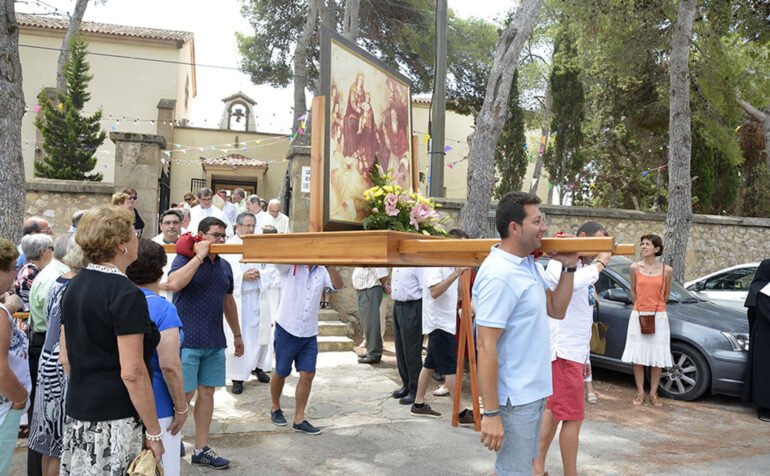Javea is a town full of magic – and every August, the Virgen de los Ángeles festival reminds locals of a real miracle that took place some 400 years ago.
Legend says that while hunting for rabbits, a local Javea resident discovered a canvas rolled up inside a tree trunk.
The canvas depicted the Virgin Mary surrounded by angels, with baby Christ in her arms and the Holy Spirit beside them (read on for the full story).
From this canvas comes the name of the still-active monastery in the Las Planas region of Javea.
Every 2nd August, on the feast day of the Virgen de los Ángeles, the canvas is carried along the roads of Las Planas as Javea locals and international visitors celebrate the Festes de la Mare de Deu dels Angels (Festivals of our Lady of the Angels).
Photo credit: Javea.com
Also read: Javea`s Fiestas
When is the festival of the Virgen de los Angeles?
The festival lasts for up to a week leading to the 2nd of August.
Where is the festival of the Virgen de los Angeles?
Festivities centre around the active monastery known as the Santuari de la Mare de Deu dels Angels (Santuario de Nuestra Señora de los Ángeles) on the Carretera del Cap de Sant Antoni in the Les Planes (Las Planas) region of Javea.
What are the highlights of the festival of the Virgen de los Angeles?
Depending on your preferences:
- Parading with the canvas of Our Lady of the Angels which appeared, as if by miracle, in the 17th century
- Enjoying a community supper with Javea locals, visitors and nuns of the Monastery of Our Lady of the Angels
- Enjoying wine and coca-maria given out by nuns
The miracle on Las Planas – the origin of the Virgen de los Ángeles festival in Javea
In the 1300s, the city of Valencia was struck by plagues that wiped out nearly half its population of 40,000.
Many fled the debauchery they believed had invoked the wrath of God. They chose to live as hermits in caves, such as those on the headland of San Antonio in Javea, whose network of caves are until today known as the Coves Santes (Sacred Caves).
Many of those who came to live in Javea were men, but the most famous devotee was undoubtedly Sor Catalina Bas.
Sor Catalina was a 14th century hermit who became one of the first women given the privilege of building a hermitage and tending to worshipers – she named the hermitage after Saint Anthony, and from there comes the name the Cabo del San Antonio.
Meanwhile the men, led by the priest Jaime Juan Ibáñez, were granted permission in 1374-1375 by Pope Gergory XI to build a monastery to the order of the Hieronymite monks – and from there comes the name of La Plana de Sant Jeroni.
Unfortunately, any peace and solace in Javea was short-lived.
In 1388, Barbary pirates ransacked the monastery. They burnt it to the ground, stole any items of worth, killed the abbot, and took eight monks as slaves.
Legend says that a Brother Dimas managed to hide a treasured painting of the Virgin Mary inside his habit, and slipped it into the hollow trunk of a tree as he was carried to the Cova Tallada and the pirate ships waiting off the coast.
As for the San Jeronimo monks who survived the attack, the Duke of Gandia gave them a new site, the Monasterio de Sant Jeroni de Cotalba.
As for the painting of the Virgen de los Ángeles, it remained intact inside the tree trunk for almost 300 years until a hunter chanced upon it while out hunting rabbits.
Reconstruction of the Santuari de la Mare de Déu dels Àngels
By 1760, two religious devotees rebuilt a hermitage upon the ruins of the old monastery, and placed the painting of the Virgin Mary inside it.
Further renovations and expansion in 1857 and 1946 retained the medieval structure of this hermitage. Then, in 1964, the present-day Santuari de la Mare de Déu dels Àngels was built to house an order of nuns which continues to this day.
Today, there are six nuns of the order of the Hijas de Santa María del Corazón de Jesús living in the Casa de Espiritualidad Nuestra Señora de los Ángeles (House of Spirituality of Our Lady of the Angels).
The canvas re-discovered as if by miracle hangs above the altar, and is carried around the streets every 2nd August in celebration.
The sanctuary is free to visit year round and carries a series of tiled paintings depicting the entire story of the original Hieronymite order, the pirate attack, and the rediscovery of the canvas. You can visit for mass at 9am Monday to Friday and Sundays at 10am.
Inside the monastery is a beautiful interior patio with a well in the centre, and vegetable patches and fruit trees out the back.
Las Fiestas de la Virgen de los Ángeles – week leading up to 2nd August
For centuries local Javea families have walked up to the Plana de Sant Jeroni to celebrate the miraculous canvas and give thanks to the Virgin Mary.
A dignitary from Valencia traditionally arrives to hold a eucharist, and in more recent years there is a disco until the early hours.
Here’s what you can expect in the week leading up to 2nd August:
- Traditional music with dolçaina and tabalet
- Traditional dancing on the Carretera de la cap de Sant Antoni, which leads to the lighthouse (and closes the road during the dance)
- Community dinners (Cena de Hermandad)
- Mobile disco
- Raffle
- Open-air brunch
- Brisca tournaments (traditional card game)
- Mass at 12pm on 2nd August presided over by a dignitary from Valencia, often the Archibishop
- After mass, a procession of the canvas depicting Our Lady of the Angels, accompanied by dolçaina and tablet instruments
- After the procession, Mistela wine and coca maria


